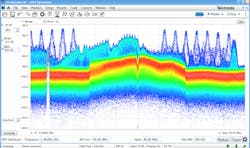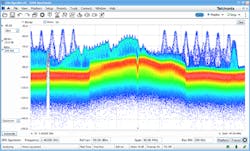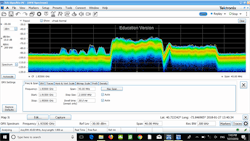These Tools Can Help You Defeat RF Interference
The explosion of wireless technology means that RF signals are literally everywhere. And that mass congestion of RF exacerbates the problem of RF interference. And with more and more wireless devices permeating our lives, the possibility clearly exists for interference to affect the performance and reliability of the wireless technology across the board.
Tracking down where interference is coming from requires the right mix of tools and techniques. In this article, we’ll explain the premise of “interference hunting” by first discussing the different types of interference, and then get into the tools that can be used to detect it, supported by actual experiment results.
Categorizing Interference
RF interference is an issue that can lead to problems like dropped calls. There are three main types of interference.1 The first is co-channel interference, which occurs when multiple transmitters are transmitting signals on the same channel. Today, essentially all frequencies are being shared. The second is adjacent channel interference, which is caused by signals that interfere with communication in adjacent frequency channels.
The third type is impulse noise, which can result from imperfect shielding that allows energy to leak and interfere with RF devices. In addition, noise can result from partial device failures, as well as other sources like industrial machinery.
Detecting Interference with Real-Time Spectrum Analyzers
Detecting interference typically involves using a spectrum analyzer. Today, suppliers offer both swept-tuned and real-time spectrum analyzers (RTSAs). While a traditional swept-tuned spectrum analyzer can be used for interference detection, it does have certain limitations when compared with an RTSA.
Swept-tuned spectrum analyzers can display measurement data by continuously sweeping across a given frequency range from the lowest to the highest frequency. This functionality allows measurement data to be displayed for each measurement step in the specified frequency range. Thus, a user can observe a spectrum display as the analyzer continuously sweeps across a range of frequencies.
However, the sweeping functionality of a swept-tuned spectrum analyzer also affects its capability to measure interfering signals. Capturing an interference signal with a swept-tuned spectrum analyzer requires that signal be present (i.e., in an “on” state) when the analyzer performs its measurement at the frequency of the interfering signal. But since a swept-tuned spectrum analyzer sweeps across a range of frequencies, the possibility exists that the interference signal is not present (i.e., in an “off” state) when the analyzer performs its measurement at the interfering signal’s frequency.
Hence, an interfering signal that is present at some instances in time when the analyzer is sweeping also may not be present at the exact point in time when the analyzer performs a measurement at that interfering signal’s frequency. In this case, the interference signal would essentially be undetected. This scenario is obviously more likely when trying to detect short-duration signals.
RTSAs differ from traditional swept-tuned spectrum analyzers, as they do not actually sweep across a frequency range. Rather they can continuously capture spectrum information for any span as high as the RTSA’s maximum real-time span. This capability enables RTSAs to capture short-duration signals, making them an essential tool for RF interference detection.
Digital Phosphor Technology
1. A DPX display is based on a color-coded scale that represents how often signals are present. The display shown reveals both WLAN and Bluetooth signals.
Digital Phosphor technology (DPX) is a feature that Tektronix offers within its RTSAs (Fig. 1).2 Like a traditional spectrum-analyzer display, a DPX display shows amplitude versus frequency measurement data. However, a DPX display utilizes a color-graded feature, with the different colors indicating the occurrence of a signal as data is being collected. In Tektronix’s SignalVu-PC software, which is used alongside the company’s RTSAs, the default DPX bitmap color option is Temperature. Therefore, signals that are present more often are represented by warmer colors, while cooler colors represent signals that occur less frequently.
Viewing a DPX display allows users to observe multiple signals at the same frequency. This capability makes it possible to see low-amplitude signals in the presence of higher-amplitude signals at the same frequency. In other words, signals buried underneath other signals can be revealed by a DPX display.
It is important to note that a DPX display is not limited by the RTSA’s real-time bandwidth. When setting the span wider than the real-time bandwidth, the DPX spectrum display is created by stepping through multiple real-time frequency segments.
RF Interference Testing
Now that we’ve discussed RTSAs and DPX displays, let’s briefly get into how RF interference can be measured in the field. To demonstrate interference testing, a measurement was conducted using the Tektronix RSA306B RTSA along with Alaris Antennas’ DF-A0047-01 handheld wideband antenna (Fig. 2). The antenna covers a frequency range of 9 kHz to 8500 MHz.
2. An antenna from Alaris Antennas was used with the Tektronix RSA306B RTSA for an interference-testing experiment.
This measurement was performed outdoors in Forest Hills, N.Y., located in the New York City borough of Queens. The center frequency of the RTSA was set to 1935 MHz, while the span was set to 40 MHz. The antenna was pointed in the air to measure RF signals. The DPX display shows a higher concentration of RF energy around 1935 MHz (Fig. 3). We won’t break down into more-detailed analysis results here; still, the example illustrates how this type of testing can enable a user to track down an interfering signal upon detection. In other words, if interference is detected, these tools allow one to simply attempt to walk or drive to the location of the origin of the interfering signal.
3. This DPX display was the result of an outdoor measurement.
This demonstration is obviously just a starting point; similar equipment could be used to conduct much more extensive interference detection tests. Tektronix also offers other features, such as mapping and the Spectrogram display feature, which are beyond the scope of this article.
In conclusion, it’s imperative now more than ever that RF interference must be addressed. And as the Internet of Things (IoT) continues to churn out more wireless products, detecting RF interference will grow in importance. Companies such as Tektronix, among others, offer the tools to help make interference hunting efforts a success.
References
1. Tektronix, Interference Hunting, Application note
2. Tektronix, DPX Acquisition Technology for Spectrum Analyzers Fundamentals, Primer




